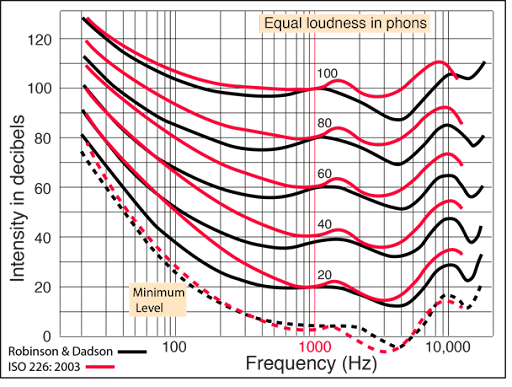Curves of Equal Loudness – What Are They and Do I Want Them?
The human ear is an interesting thing. We rely on it and some people think it is more sensitive than any measurement device out there (they are wrong). But science has shown us that our hearing has limitations. We lose the ability to hear the highest notes as we age (remember the mosquito noise that was all the rage a while ago?). More importantly, as volume decreases, we hear some frequencies better than the others. In general, as the volume reduces, we perceive the lowest bass and highest treble to be quieter than the other frequencies. To combat this phenomenon, scientists have come up with curves of equal loudness. But what are they are should you want them?
What is a Curve of Equal Loudness?
There are many articles that cover this, but, in brief, curves of equal loudness were first described by Harvey Fletcher and Milden A. Munson in the 1930s. Through their research, they discovered that we perceive some frequencies as louder than others at specific volumes. So, if you took a 50Hz note and a 10kHz note and played them at the same volume, one would sound louder to you than the other (the 10kHz one). As you increased the volume of both, the differences would reduce. As you decreased the volumes, the differences wound increase.
Curves of equal loudness (the first of which were Fletcher-Munson Curves) were created so that audio mixers would be able to accurately mix music so that every note sounded as loud as they expected. While the equipment may tell the mixer that the notes were all at the same volume (SPL), applying the curves of equal loudness ensures that it all sounded the same to the listener.
Applications in Home Theater
Nearly all name-brand receivers these days come with some sort of room correction system. These programs are designed to calibrate your speakers and to correct for any problems your room may create. They nearly all have some sort of “loudness” setting that you can switch on or off. Most default to on. Denon and Marantz have Audyssey’s Dynamic EQ, Yamaha has YPAO Volume, THX has Loudness Plus. These are all based on curves of equal loudness.
The thing is that most people don’t really understand how sound works. Specifically in home theater. They want to plug in a device (usually a soundbar) and just have everything work. They don’t need to know that their device is applying curves of equal loudness. But you can believe that they will complain if they can’t hear any bass out of their new soundbar!
HDMI is trying to make things plug-and-play with CEC (poorly most of the time). But we are not most people. We want control over our systems and we want to choose what our receivers do and need to know why it is doing what it is. So, let’s dive in.

Curves of Equal Loudness in Action
At reference level (0dB on the volume dial), your “loudness” compensation isn’t doing much. This is because the movie or content should have been mixed so that the curve of equal loudness was applied at that volume. But if you’ve ever spent any time with your volume knob at 0dB, you know it is VERY loud. You’ll generally want to turn it lower.
This is where your loudness compensation comes in.
As you lower your volume so that the average volume is at a more comfortable level, you will experience some sounds as lowering in volume more quickly than others. Namely much of the bass and some of the treble. Your loudness compensation program will offset these perceptual differences by lowering the volume of the bass and treble frequencies less than the rest.
Do You Want Loudness Compensation?
In a word? Yes. Everything will sound more natural, you’ll perceive the bass, midrange, and treble as all being the same volume. These are all good things. Curves of equal loudness were built so that your perception of the volume matches the number on the dial.
The key here is that the bass and treble volume is still being reduced, just not at the same amount. You will perceive the volume to reduce the same but, objectively, it isn’t. As what really matters is how loud you perceive the sound, it is better to have curves of equal loudness engaged than not.
Now, if you are turning the volume down because you are trying not to disturb other people in the house, loudness compensation is not your friend. You don’t have to turn it off, so to speak, but it isn’t helping matters. For making things quieter but still audible, most room correction programs have different functions to help.
Do you use loudness compensation? How do you like it? Let us know in the comments below!


